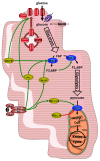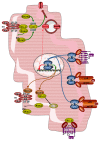JAK-STAT signaling and myocardial glucose metabolism
- PMID: 24416656
- PMCID: PMC3876426
- DOI: 10.4161/jkst.26458
JAK-STAT signaling and myocardial glucose metabolism
Abstract
JAK-STAT signaling occurs in virtually every tissue of the body, and so does glucose metabolism. In this review, we summarize the regulation of glucose metabolism in the myocardium and ponder whether JAK-STAT signaling participates in this regulation. Despite a paucity of data directly pertaining to cardiac myocytes, we conclude that JAK-STAT signaling may contribute to the development of insulin resistance in the myocardium in response to various hormones and cytokines.
Keywords: JAK; Janus kinase; SOCS; STAT; cardiac myocytes; glucose metabolism; insulin; insulin resistance; myocardium; signal transducer and activator of transcription; suppressor of cytokine signaling.
Figures


Similar articles
-
Insulin-like growth factor-I receptor signal transduction and the Janus Kinase/Signal Transducer and Activator of Transcription (JAK-STAT) pathway.Biofactors. 2009 Jan-Feb;35(1):76-81. doi: 10.1002/biof.20. Biofactors. 2009. PMID: 19319849 Review.
-
Jak/STAT/SOCS signaling circuits and associated cytokine-mediated inflammation and hypertrophy in the heart.Shock. 2006 Sep;26(3):226-34. doi: 10.1097/01.shk.0000226341.32786.b9. Shock. 2006. PMID: 16912647 Review.
-
The role of JAK-STAT signaling in adipose tissue function.Biochim Biophys Acta. 2014 Mar;1842(3):431-9. doi: 10.1016/j.bbadis.2013.05.030. Epub 2013 Jun 2. Biochim Biophys Acta. 2014. PMID: 23735217 Free PMC article. Review.
-
JAK/STAT3 pathway is involved in survival of neurons in response to insulin-like growth factor and negatively regulated by suppressor of cytokine signaling-3.J Biol Chem. 2005 Sep 9;280(36):31830-40. doi: 10.1074/jbc.M501316200. Epub 2005 Jul 5. J Biol Chem. 2005. PMID: 15998644
-
Suppressors of cytokine signaling (SOCS): inhibitors of the JAK/STAT pathway.Shock. 2002 Feb;17(2):83-90. doi: 10.1097/00024382-200202000-00001. Shock. 2002. PMID: 11837794 Review.
Cited by
-
Recent advances in JAK inhibitors for the treatment of metabolic syndrome.Front Pharmacol. 2023 Aug 24;14:1245535. doi: 10.3389/fphar.2023.1245535. eCollection 2023. Front Pharmacol. 2023. PMID: 37701031 Free PMC article. Review.
-
Small-molecule-mediated reprogramming: a silver lining for regenerative medicine.Exp Mol Med. 2020 Feb;52(2):213-226. doi: 10.1038/s12276-020-0383-3. Epub 2020 Feb 20. Exp Mol Med. 2020. PMID: 32080339 Free PMC article. Review.
-
IL-15 Activates the Jak3/STAT3 Signaling Pathway to Mediate Glucose Uptake in Skeletal Muscle Cells.Front Physiol. 2016 Dec 20;7:626. doi: 10.3389/fphys.2016.00626. eCollection 2016. Front Physiol. 2016. PMID: 28066259 Free PMC article.
-
Identification of hub genes and immune-related pathways in acute myeloid leukemia: insights from bioinformatics and experimental validation.Front Immunol. 2025 Jan 10;15:1511824. doi: 10.3389/fimmu.2024.1511824. eCollection 2024. Front Immunol. 2025. PMID: 39867885 Free PMC article.
-
Insulin-mediated endothelin signaling is antiviral during West Nile virus infection.bioRxiv [Preprint]. 2023 Jan 18:2023.01.17.524426. doi: 10.1101/2023.01.17.524426. bioRxiv. 2023. Update in: J Virol. 2023 Oct 31;97(10):e0111223. doi: 10.1128/jvi.01112-23. PMID: 36712090 Free PMC article. Updated. Preprint.
References
-
- Opie LH. The Heart: Physiology, from Cell to Circulation 3rd ed. Philadelphia, New York: Lippincott-Raven; 1998.
-
- Stryer L. Biochemistry 2nd ed. San Francisco: W.H. Freeman and Company; 1981.
Publication types
LinkOut - more resources
Full Text Sources
Other Literature Sources
